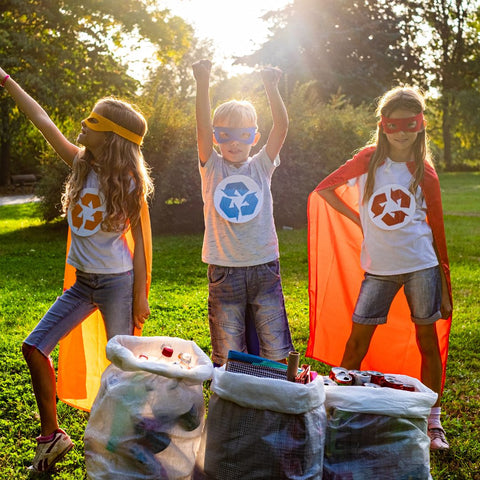
National Earth Day is more than just a date on the calendar; it's a fantastic opportunity to bond with your kids over something incredibly important—caring for our planet.
But how do you transform this passion into practical, everyday actions?
Let's break it down into engaging activities, complete with the nitty-gritty on how to make them both educational and fun.
Understanding Earth Day
Bringing the Story to Life
Activity: Create a time capsule or a scrapbook that captures the essence of Earth Day.
Start with a little research project: Research the origins of Earth Day, learn about key environmental activists, and identify major milestones in the conservation movement.
How: Gather information using online resources or a trip to the library.
Then, let your kids pick out what resonates with them most.
They can draw pictures, write short summaries, or even create a comic strip to illustrate their findings.
Connecting with Nature
Interactive Nature Walks
Activity: Go on a nature scavenger hunt. Make a list of things to find or observe in nature—different types of leaves, insects, birds, or even signs of the changing seasons.
How: Equip your kids with a small notebook or a camera to document their discoveries.
Discuss each item on your list, why it's important, and how it fits into the ecosystem.
This teaches observation skills and fosters a deeper appreciation for the diversity of life around us.
Family Gardening Project
Activity: Start a small vegetable or flower garden. If space is limited, container gardening is a great alternative.
How: Choose plants that are easy to grow and maintain. Involve your kids in every step, from selecting seeds to daily care.
This hands-on experience teaches responsibility and shows the cycle of life, from seed to harvest.
Identifying Local Flora and Fauna
Get to know your green neighbors! Equip your family adventure with a local wildlife and plant guidebook or use an app to identify species.
As you walk through your local park or even your garden, encourage your kids to spot and identify different plants, trees, and animals.
Discuss their roles in the ecosystem and fun facts about each.
This activity not only connects children with their local environment but also teaches them the value of biodiversity.
Sustainable Practices at Home
Mastering the Art of Recycling
Activity: Set up a home recycling centre. Designate bins for different materials and decorate them with your kids to make the process visually appealing.
How: Teach by example how to clean and sort recyclables.
Turn it into a game by challenging your kids to find recyclable materials around the house. This reinforces the concept of reducing waste tangibly.
Energy and Water Conservation Workshop
Activity: Conduct a home energy audit with your kids. Identify areas where you can save energy and water, such as fixing leaks or switching to LED bulbs.
How: Create a checklist of energy-saving tasks and assign responsibilities.
Use a chart to track your family's progress in reducing utility bills, turning conservation into a visible achievement.
Starting a Compost Bin
Turning kitchen scraps into garden gold is a fantastic way to teach kids about the cycle of life and the value of reducing waste.
Start by choosing a spot for your compost bin or pile. Then, explain what can be composted—like fruit and vegetable scraps, eggshells, and coffee grounds—and what should be avoided.
As you add to the bin and turn it over time, discuss how composting works and its benefits for the Earth, like reducing landfill waste and enriching soil.
Water-Saving Practices at Home
Water is precious, and conserving it is easier than you might think.
Show your kids simple ways to save water, such as collecting rainwater for watering plants, fixing drippy faucets, and choosing drought-resistant plants for your garden.
Explain how these small acts can make a big difference in preserving our planet's water resources.
Learning and Creating Together
Environmental Movie Night
Activity: Choose documentaries or films with environmental themes. After watching, discuss the main points and what actions your family can take.
How: Make it interactive by preparing discussion questions in advance.
Encourage your kids to express their feelings about what they watched and brainstorm solutions to environmental issues highlighted in the film.
Upcycling Art Projects
Activity: Collect materials that would otherwise be thrown away and use them for art projects.
Think old magazines, scraps of fabric, or plastic bottles.
How: Challenge your kids to create an art project using only recycled materials.
This encourages creativity while teaching the importance of upcycling.
Display their creations prominently to celebrate their effort and ingenuity.
DIY Eco-Friendly Cleaning Products
Mix up some eco-friendly magic with ingredients like vinegar, baking soda, and lemon.
Guide your kids through making a simple all-purpose cleaner by mixing these natural ingredients in a spray bottle.
As you create, discuss the importance of choosing non-toxic products and the impact of chemicals on our waterways and health.
This hands-on activity not only teaches environmental responsibility but also shows kids how to care for their home in a sustainable way.
Taking Action
Plan a Family Volunteer Day
Activity: Choose a local environmental organisation or event, such as a tree planting day, beach clean-up, or community garden, where your family can volunteer.
How: Contact the organisation ahead of time to find out about age-appropriate activities.
Prepare your kids by discussing what the organisation does and what to expect.
Reflect on the experience afterwards to reinforce the importance of community involvement.
Setting Eco-Goals
Activity: As a family, set specific, achievable environmental goals.
These could range from reducing household waste to going car-free one day a week.
How: Create an "Eco-Goals" chart and track your progress. Celebrate achievements with eco-friendly rewards, like a day out in nature.
This motivates and teaches kids the value of setting and working towards goals.
Adopt-a-Plant or Tree
In the heart of the UK, there's a beautiful way for families to contribute directly to the conservation of our precious natural landscapes—by adopting a plant or tree through dedicated organizations.
Initiatives like the Woodland Trust's "Adopt a Tree" program offer a unique opportunity for you and your children to become guardians of the natural world.
By participating, you help support the conservation of woodlands and the rich biodiversity they support.
Moreover, various other organizations, including the Yorkshire Sculpture Park, the National Trust, the Urban Forest Initiative in Kentucky, The Wildlife Trusts, and Trees for Life in Scotland, run similar adoption programs.
These programs not only contribute to the preservation of green spaces and habitats but also allow individuals and families to make a meaningful impact on their local ecosystem.
Adopting a plant or tree can be a wonderful family activity that goes beyond a simple donation.
Often, these programs offer updates on the conservation efforts and sometimes even allow you to visit your adopted tree or plant.
It's a tangible connection to the environment, offering a sense of stewardship and responsibility towards nature.
Celebrating Earth Day Globally
Learning About Earth Day Around the World
Earth Day is a global event, celebrated in many different ways around the world.
Take some time to learn about Earth Day traditions in other countries with your kids.
Whether it's Japan's focus on energy conservation or Brazil's tree planting ceremonies, exploring these global perspectives can broaden your children's understanding of environmental stewardship and the worldwide community working towards a healthier planet.
Reflecting and Setting Goals
Eco-Friendly Product Challenge
Encourage your kids to become eco-detectives with a mission to find sustainable alternatives to everyday products.
This could be a bamboo toothbrush instead of a plastic one, cloth shopping bags, or beeswax wraps instead of plastic cling film.
Research together the benefits of these alternatives and discuss why choosing eco-friendly products matters.
This challenge can inspire thoughtful choices and foster a sense of agency in kids about their impact on the environment.
Get in Touch 🚀
Loved our article on “How to Teach Your Kids About National Earth Day” Got the itch to dive into more wheely-awesome info?
Whether you're a parent or a grandparent, we're here for all your kids ride-on toy questions! 🚗💨
Feeling click-happy?
Jump straight into our wonderland at RiiRoo.com.
Or, if you're more the chatty type, give our Live Chat a whirl and let's talk toys!







Share:
How to Teach Your Kids About National Unicorn Day
Teaching Your Kids About International Nurses Day (With Free Downloadable)